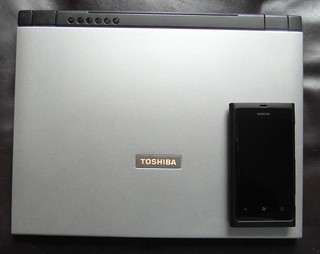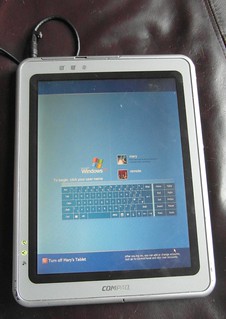2002 Ultrabooks & tablets, more memory for Windows 8?


Windows 8 won't run on every XP-era PC; watch out for PAE
Looking for a PC in the office that still had Windows XP on to upgrade to Windows 8 Consumer Preview this week meant digging down below the variety of test machines (from 17" notebooks to netbooks) that had had Windows 7, on to some of the oldest boxes in the office; the PCs I bought when I first started work as a freelance writer in 2001. The desktop I used has long since been donated to charity but the portable PCs I relied on are still tucked away in a corner.
The Toshiba Portégé R100 (and the Portégé 2000 I started out with, which it replaced after a glass of red wine tipped into the keyboard proved fatal) was practically the first Ultrabook. Thin and light, 11" screen, excellent keyboard for the size and with a second battery that put the keyboard at an excellent typing angle it ran for six hours with the Wi-Fi off. It was pricey but I wrote hundreds of thousands of words on it and it was an ideal travelling machine with handy features notebooks today are often still missing, like a hardware Wi-Fi switch. Sony offered a very pretty VAIO but it made architectural compromises like halving the amount of memory the Toshiba supported.
The Toshiba R100, with Lumia 800 for scale
Sadly, so far the R100 isn't booting; it complains about a CMOS problem, asks me to press F1 but never loads the BIOS screen. My HP TC1000, however, booted up first time. It took quite a while to display the XP front screen, perhaps because it was counting up the 534 unread messages it wanted me to know about. Who says putting notifications on the Windows 8 lock screen is a strange new idea…
Live tiles: Windows XP had a notification screen
Not only did the TC1000 boot; it resumed from hibernation, loading a session of Windows I last used in March 2006. AVG warned me that it was out of date and as we've changed the name of our wireless access point I had to fill that in and wait a couple of minutes, but nearly six years later my PC just turned back on ready to work.
Turning on the TC1000 six years later, and here’s the last email I was reading
The TC1000 was HP's first tablet PC, with a design that people were always mistaking for Apple. From the boot screen telling you to press the jog wheel to load setup utilities, to the high quality array microphones for recording meetings or placing VOIP calls to an active pen that wrote smoothly on screen to two tiny flip up feet to put the surface at a great angle for writing to a physical keyboard with a trackpoint and two mouse buttons that clipped onto the screen to turn it into a perfectly balanced notebook you could perch on your lap, it was a beautifully thought out machine.
The drawback was the Transmeta processor, which never delivered the performance the designers promised (something that makes me glad Microsoft has resisted the temptation to emulate Win32 apps on the ARM processor) - and the combination of a high price and stores that only displayed it with the keyboard attached. HP replaced the Transmeta processor with the first Centrino but didn't take advantage of the Centrino features that could have improved battery life and then decided it just wasn’t selling (disappointing both TC1000 fans like me and the then-new HP head of marketing who had just arrived from Apple and had big plans for promoting the most stylish PC in the portfolio). To the shareholder who recently asked Meg Whitman why HP wasn't selling devices hand over fist like Apple, I'd say 'because when HP has a potential winner like this, it lets it slip through its fingers'.
I had hoped the 995MHz of the Transmeta Crusoe would let it squeak in under the bar; Windows 8 needs a 1GHz processor to run. Rummaging through the box of obsolete memory produced most of the extra RAM needed to take it to the necessary 1GB. But in between burning the Windows 8 install ISO to DVD (no USB boot for such early XP systems) and opening the neat little hatch to install the memory, we tried the Windows 8 DVD on Simon's Pentium M Toshiba Portégé M200 tablet, which had enough memory already and what we expected to be a fast enough processor. Alas, it turns out the 400MHz FSB Pentium M doesn't have the PAE-NX extensions, and neither does the Transemta Crusoe - and Windows 8 demands those.
That's bad news for our attempts to upgrade Windows XP systems to Windows 8 but it does hold out the tempting prospect that Windows 8 might be able to address more than 4GB of RAM on 32-bit systems at last. That was in testing for Windows XP SP2 but it was never enabled for more than Data Execution Protection (which uses the NX bit) because too many drivers crashed when it was turned on.
According to Windows expert (and now Microsoft employee) Mark Russinovich, "many of the systems would crash, hang, or become unbootable because some device drivers, commonly those for video and audio devices that are found typically on clients but not servers, were not programmed to expect physical addresses larger than 4GB. As a result, the drivers truncated such addresses, resulting in memory corruptions and corruption side effects." It wasn't a problem on Windows Server because there are far fewer peripherals plugged into the average server, and far less complex graphics cards and drivers, so the 32-bit version of Windows Server 2003 Enterprise supported 32GB of RAM (and 64GB in SP1). The Standard version stayed at 4GB; a cynic might say that was to make sure anyone who could afford 32GB of RAM was paying more for their server OS licence. Microsoft is a commercial company after all...
By now, drivers are far more reliable. We've moved on from the days when a single driver that Microsoft wouldn't publicly name was responsible for 80% of Windows blue screen STOP errors (cough *graphics card makers* cough). 32-bit PCs haven't vanished from the market the way we all expected because of Atom netbooks (although the demands for low-power servers and Intel's desire to avoid losing that market to ARM means we will see 64-bit Atom processors in the not too distant future). Maybe we'll be able to improve the performance of Atom PCs, especially tablets like the Kupa K11-Pro and the Fujitsu Stylistic Q550, by giving them 6GB of RAM with Windows 8.
Mary Branscombe


